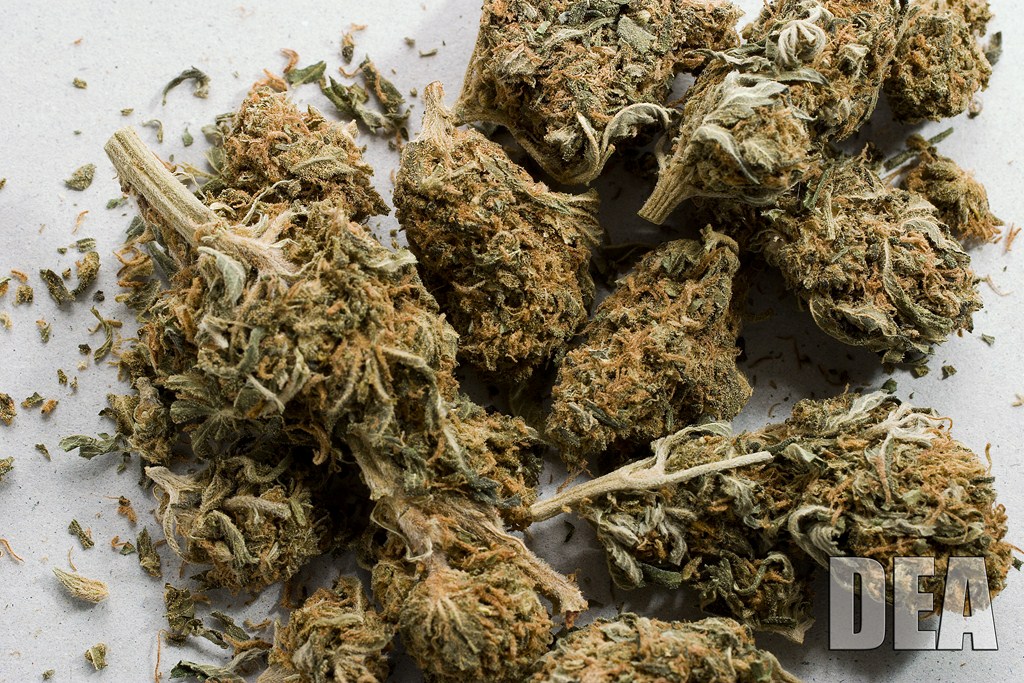Cannabis sativa L. is a plant that grows wild throughout most of the tropic and temperate regions of the  world. Three drugs that come from cannibis - marijuana, hashish, and hashish oil - are distributed on the U.S. illicit market. THC (delta-9-tetrahydrocannabinol) is believed to be the main chemical ingredient that produces the psychoactive effect.
world. Three drugs that come from cannibis - marijuana, hashish, and hashish oil - are distributed on the U.S. illicit market. THC (delta-9-tetrahydrocannabinol) is believed to be the main chemical ingredient that produces the psychoactive effect.
What are the street names?
Blubbers, Boom, Gangster, Ganja, Grass, Hashish/Chara, Herb, Pot, Reefer, Weed
What does this drug look like?
Marijuana is a dry, shredded green/brown mix of flowers, stems, seeds, and leaves from the Cannabis sativa plant. The mixture typically is green, brown, or gray in color and may resemble tobacco. Hashish is collected, dried, and pressed into a variety of forms, such as balls, cakes, or cookie-like sheets. Hashish oil is a viscous liquid ranging from amber to dark brown in color.
How is this drug abused?
Cannabis products are usually smoked.
How does this drug affect the mind?
Cannabis is abused for its euphoric effects. When cannabis is smoked, the THC passes from the lungs and into the bloodstream, which carries the chemical to the organs throughout the body, including the brain. In the brain, the THC connects to specific sites called cannabinoid receptors on nerve cells and influences the activity of those cells. Many of these receptors are found in the parts of the brain that influence pleasure, memory, thought, concentration, sensory and time perception, and coordinated movement. The short-term effects of cannabis include problems with memory and learning, distorted perception, difficulty in thinking and problem-solving, and loss of coordination. The effect of marijuana on perception and coordination are responsible for serious impairments in driving abilities. Long-term chronic use is associated with "Amotivational Syndrome", characterized by apathy, impairment of judgment, memory and concentration, and loss of motivation, ambition and interest in the pursuit of personal goals. High doses can result in mental confusion, panic reactions and hallucinations.
How does this drug affect the body?
Short-term physical effects may include sedation, blood shot eyes, increased heart rate, coughing from lung irritation, increased appetite, and decreased blood pressure. Like tobacco smokers, cannabis smokers experience serious health problems such as bronchitis, emphysema, and bronchial asthma. Extended use may cause suppression of the immune system. Because cannabis contains toxins and carcinogens, cannabis smokers increase their risk of cancer of the head, neck, lungs and respiratory track. Withdrawal from chronic use of high doses of cannabis causes physical signs including headache, shakiness, sweating, stomach pains and nausea, as well as behavioral signs including restlessness, irritability, sleep difficulties and decreased appetite.
What are the overdose effects?
There have been no reported deaths by overdose.
What is the legal status in the United States?
Cannabis and THC are schedule I substances under the Controlled Substances Act. Schedule I drugs are classified as having a high potential for abuse, no currently accepted medical use in treatment in the United States, and a lack of accepted safety for use of the drug or other substance under medical supervision. Marinol, a synthetic version of THC, the active ingredient found in the marijuana plant, can be prescribed for the control of nausea and vomiting caused by chemotherapeutic agents used in the treatment of cancer and to stimulate appetite in AIDS patients. The FDA approved product, Marinol is a schedule III substance under the Controlled Substances Act. Schedule III drugs are classified as having less potential for abuse than the drugs or substances in Schedules I and II and have a currently accepted medical use in treatment in the U.S., and abuse of the drug may lead to moderate or low physical dependence or psychological dependence.
What are the common places of origin?
Cannabis is grown in the United States, Canada, Mexico, South America and Asia. It can be cultivated in both outdoor and in indoor settings.
